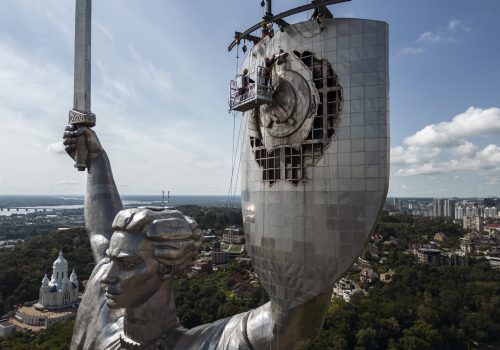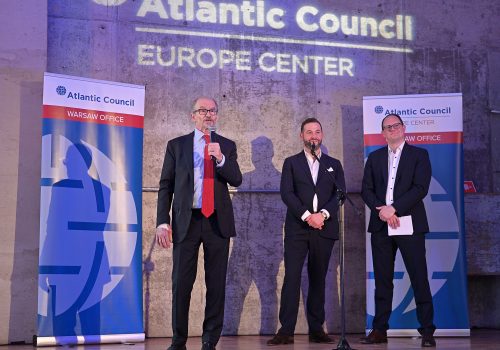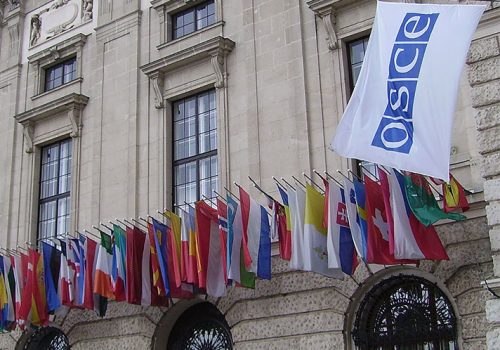Fifty years later, the Helsinki process stands as a turning point for human rights in Europe
In September 1973, participants from nearly three dozen countries met in Geneva to begin the substantive working phase of negotiations as part of the Conference on Security and Cooperation in Europe (CSCE). Fifty years later, these negotiations have had an unlikely legacy that neither the CSCE’s critics nor its proponents would have guessed at the time. Originally a Soviet proposal, the CSCE started as a negotiating framework through which the axioms of détente in Europe could be formalized. The negotiations, long and elaborate, produced the Helsinki Final Act, signed in August 1975 by thirty-five nations.
In a reversal of Soviet expectations and many Westerners’ fears, the Final Act’s recognition of post–World War II territorial realities turned out to be pro forma, while the human rights commitments in the document were the dynamic and lasting elements of the Final Act. Indeed, the phrase “Helsinki process” became synonymous with human rights activism and monitoring in the Soviet Union and Eastern bloc. Upending the expectation that the Final Act would legitimize communist rule in Central and Eastern Europe, it instead contributed to trends that would ultimately end it.
Structure of peace
By the early 1970s, when the Helsinki Accords were negotiated, President Richard Nixon and his National Security Advisor Henry Kissinger had settled on a Cold War strategy with the following elements: the containment of Soviet power, including resisting communist expansion; arms control, to reduce the risks of superpower confrontation; and, framed by the first two elements, a general relaxation of tensions with the Soviet Union, commonly known as détente. Taken together, these elements constituted a long-term “structure of peace,” as Nixon put it.
Nixon developed his Cold War strategy in the context of the United States’ struggles in the Vietnam War and its parallel effort to improve relations with China, then at odds with Moscow. It made sense at the time. Détente gave the United States greater tactical flexibility in dealing with Moscow and Beijing, and it reduced the danger of a general US-Soviet war, both considerable achievements.
Implicit in the Nixon-Kissinger structure of peace, however, was a tacit acceptance of Soviet domination over Eastern Europe. Nixon made that nearly explicit: “We are aware,” he wrote to Congress in 1970, “that the Soviet Union sees its security as directly affected by developments in [Eastern Europe] . . . It is not the intention of the United States to undermine the legitimate security interests of the Soviet Union.” This view reflected an assumption, nearly universal if often unspoken within the US foreign policy community, both in and out of government, that the line of the Iron Curtain, imposed by Soviet leader Joseph Stalin in and after 1945, was permanent; that the “satellite countries” of Central and Eastern Europe were doomed to remain dominated by Moscow; and that efforts to change that fate, whether through revolt as in Hungary in 1956 or reform as in Czechoslovakia in 1968, would end in failure.
For Moscow, détente offered strategic parity with the United States; limited competition beyond Europe that the Soviets could intensify as opportunities arose; some US and much more Western European trade, loans, credits, and investment; and acceptance, however disguised, of the Soviet Union’s European empire, the imposition of which had been the original cause of the Cold War. This was the best deal the Soviet Union ever got from the United States, which explains the persistent Soviet (and later Russian) affection for the Nixon administration.
These were the conditions under which the CSCE process began. The Helsinki Accords, the eventual product of the CSCE’s negotiations, consisted of three “baskets.” Basket one gave political backing to the post–World War II European borders and, by implication, to the status quo of divided Europe. The Soviets liked that part a lot. Basket two included economic cooperation, which they liked as well. But basket one also contained references to human rights and fundamental freedoms. Moreover, Helsinki’s basket three, with equal standing, upheld an agenda of social and cultural contacts and access to information.
The Soviets had resisted the inclusion of human rights in the Helsinki package, but in the end agreed to it as a necessary price for a document that seemed to enshrine Europe’s territorial and even its political status quo. From a Soviet perspective this risk was acceptable: the Helsinki Final Act’s language about human rights might well have proven as meaningless in practice as had the words of the Declaration of Liberated Europe that Stalin had agreed to at Yalta. The Helsinki Final Act seemed to be a pretty good deal for Moscow.
Many on the political right in the United States reached the same conclusion—that the Helsinki Accords ratified the division of Europe and legitimized the Iron Curtain—and attacked Kissinger and then-President Gerald Ford for having signed them.
The Final Act’s lasting impact
As it turned out, however, the provisions on human rights became the most lasting elements of the Helsinki Final Act. Rather than being consigned to a junk heap of empty rhetoric, the Helsinki Final Act’s language on human rights became the most dynamic part of the lengthy document. This was due to the shift on the ground in the Soviet Union and Europe east of the Iron Curtain, an unanticipated and welcome byproduct of détente.
Under conditions of détente, feeling relatively confident and seeking to deepen the benefits it implied, the Soviets cautiously widened the possibilities for contacts with the West. US-Soviet student and cultural exchanges expanded. US journalists were able to spend time in Moscow and Leningrad under somewhat more open conditions. Traveling US government exhibits of US culture toured the Soviet Union. A generation of young US Soviet specialists, including future Secretary of State Condoleezza Rice, future Undersecretary of State Victoria Nuland, future US Ambassador to Moscow John Beyrle, and many others, myself included, had the opportunity to gain access to Soviet society in ways unthinkable for an earlier generation of Soviet specialists like George Kennan.
US and Western European journalists, students, scholars, and young diplomats in Moscow were able to develop contacts with an emerging generation of Soviet dissidents. Russians, especially in Moscow and Leningrad, had outlets and contacts with Westerners their parents couldn’t have dreamed of. This opening went even further in communist-ruled Central and Eastern Europe, where US and Western European journalists, students, and scholars started meeting dissidents who were becoming more outspoken and even organized in underground and semi-underground fashion, especially in Poland. US embassies in the region started assigning diplomats to “human rights” portfolios, with the job of maintaining contacts with unofficial, independent thinkers. All this meant that the Soviet Union and its empire were no longer abstractions to the West; dissidents’ ideas were entering the consciousness and vocabulary of journalists, students, diplomats, and scholars. The numbers of these dissidents were tiny but their influence was outsized.
In the aftermath of the adoption of the Helsinki Final Act, “Helsinki Committees” or “Helsinki Watch” groups sprang up in the Soviet Union and throughout Eastern Europe, monitoring the application of the Final Act’s human rights principles, sometimes detailed, to which their governments had recently agreed. Thanks to détente, the habits and means of contact between them and the West were in place. An infrastructure of human rights groups grew in the West and, albeit under conditions of repression, east of the Iron Curtain.
This human rights activism in the Soviet Union and especially Eastern Europe, boosted by the use to which activists put the Helsinki Final Act, continued through the 1970s, just as Soviet and eastern bloc economic fortunes began their terminal decline. The Soviets of the Brezhnev era sought Western economic support—Western technology legally or otherwise obtained, credits, investment, and loans—to boost productivity and obviate the need for deep economic reforms that communist rulers rightly feared would weaken their political control. Some of this economic support was forthcoming, especially from West Germany. But there was not enough of it to compensate for the deepening sclerosis of the communist system.
By the end of the 1970s, democratic dissent was on the rise, especially in Poland, while the communist economies were sagging. Communist regimes were on the defensive. The harbinger of the fall of the Soviet empire took place in Poland in 1980, with the rise of Solidarity, simultaneously a trade union and mass political movement that united democratic dissidents with Polish shipyard and factory workers. The communist system in Poland never really recovered and in 1989 the entire communist system in Eastern Europe collapsed.
The Helsinki Final Act did not cause the end of communist rule in Europe. Yet, although originally intended to be the underpinnings of détente and thus the status quo in Europe, it may have encouraged and accelerated the trends that helped end that status quo. Kissinger may not have had this result in mind when advancing the Helsinki Final Act negotiations as part of his policy of détente. Indeed, he later wrote of the CSCE process: “Turning points often pass unrecognized by contemporaries.” Fifty years later, it is easier to recognize the CSCE and the Helsinki Accords it produced as a turning point for the advancement of human rights in Central and Eastern Europe.
Daniel Fried is the Weiser Family distinguished fellow at the Atlantic Council and former US ambassador to Poland.
Further reading
Tue, Aug 1, 2023
Ukraine is finally freeing itself from centuries of Russian imperialism
UkraineAlert By
Vladimir Putin hoped his full-scale invasion of Ukraine would mark the dawn of a new Russian Empire. Instead, it has strengthened Ukraine's resolve to free itself from centuries of Russian imperialism, writes Taras Kuzio.
Thu, Jun 1, 2023
How the United States and Poland can use this moment to reshape transatlantic security
New Atlanticist By Daniel Fried
Poland and the United States must keep Ukraine front and center, maintain transatlantic unity, and champion democratic values. Our Warsaw Week charted a way forward.
Wed, Jan 12, 2022
Strengthening the OSCE’s role in strategic stability
Strategic Insights Memo By Marina Favaro
Over the past year, the Scowcroft Center for Strategy and Security has hosted a private workshop with several international experts and officials to discuss how to strengthen the OSCE’s role in strategic stability. In this strategic insights memo, the Transatlantic Security Initiative advances a new understanding for policymakers regarding how emerging technologies should factor into forthcoming arms control regimes.
Image: President Ford Addressing Delegates in Finlandia Hall during the Plenary Session of the Conference on Security and Cooperation in Europe (CSCE) in Helsinki, Finland.


